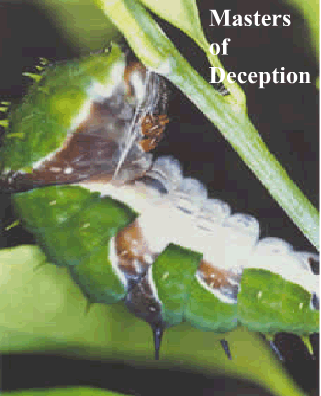Masters of Deception
part 1

1) The four stages of the butterfly life-cycle, in order, are = egg, larva (caterpillar), pupa (chrysalis) and the adult (butterfly)
2) Another name for the butterfly is the = the adult
3) The butterfly has a specialist role in = reproduction
4) The resting stage in the life cycle is called the = pupa
5) The egg contains = both caterpillar and butterfly cells
6) Explain what happens inside the egg as it matures?
Chemicals called hormones label cells to become either butterfly or caterpillar cells. Once labeled the caterpillar cells thrive and grow in size while the butterfly cells remain dormant.
7) Levels of the hormone ecdysone in the caterpillar's body = promotes the moulting of its skin
8) Juvenile hormone has the effect of = encouraging the development of the caterpillar cells while keeping ht butterfly cells int eh caterpillar's body from growing.
9) The caterpillar's specialised role is = feeding
10) Insects such as the caterpillar breath through = tiny holes along their body, called spiracles
11) Explain what happens in the pupa?
During the resting phase the butterfly cells grow while feeding off the body of the caterpillar.
12) Why is it important for the caterpillar to eat and grow as much as possible?
It is important to provide the butterfly cells with as much food as possible as they grow and develop. The food provided for the butterfly comes from the body of the caterpillar. The bigger and fatter the caterpillar is the more food the butterfly cells have to feed on.
13) The caterpillar has suction-cup type legs. Explain how these help the caterpillar in its specialist role?
14) What is the role of the cremaster? = to attach the caterpillar, which will later form the pupa, firmly to a tree.